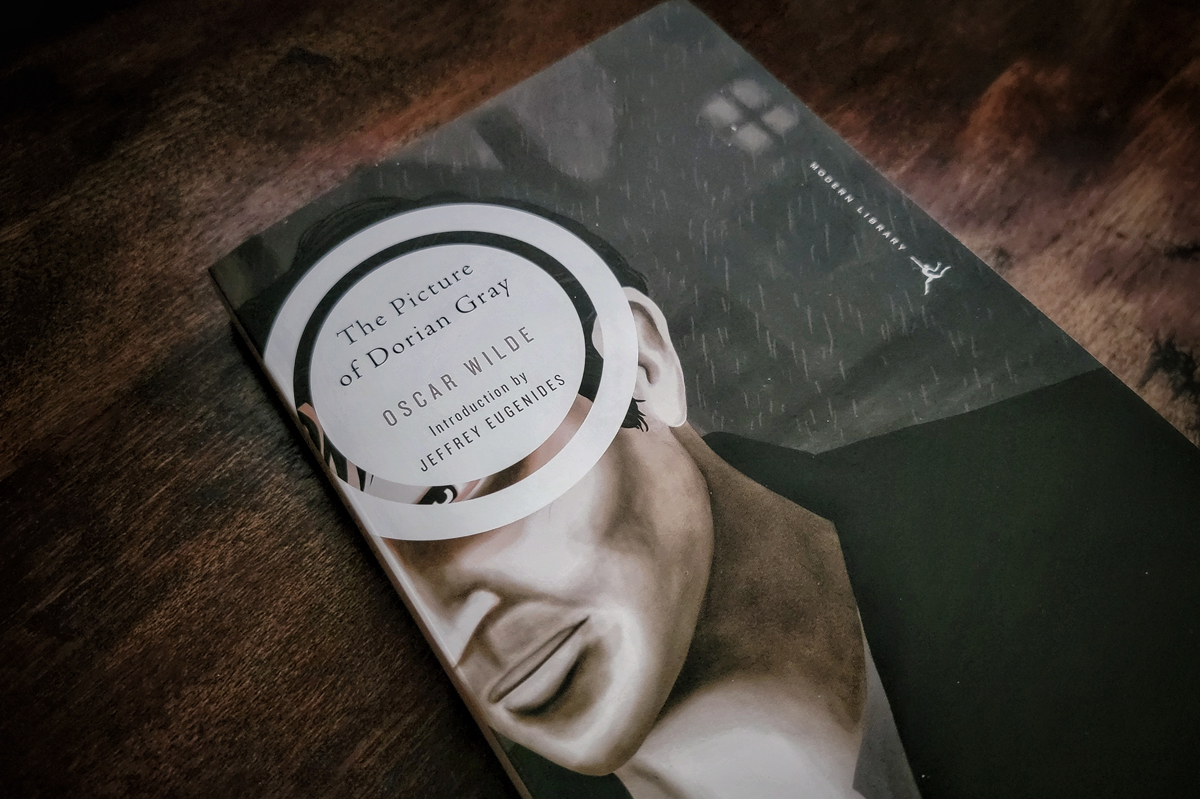Book Review: The Picture of Dorian Gray

I have been so knee-deep in theology books over the last few years that I haven’t spent much time reading novels. But when my priest recommends one to me, I am always sure to squeeze in some time to read it. The most recent novel I was led to is a classic by Oscar Wilde. As a quick background about the author, Oscar Wilde was a 19th Century Catholic convert who was imprisoned for his struggle with homosexuality. Wilde’s internal battles set the stage for The Picture of Dorian Gray, a controversial book widely criticized by his contemporaries, which I’ll be reviewing here today.
When Joaquin Phoenix’s The Joker was released in 2019, I felt sick to my stomach watching the film in theaters. The directors brilliantly highlighted the perverse consequences of sin and what ultimately happens when we continually place our own desires before the common good. Sin makes our souls sick, in fact so sick that we often don’t know it. The film did a terrific job filling viewers with the disgust that we ought to have over sin. My body felt how my soul does when I turn from Christ.
My stomach turned much the same way while reading The Picture of Dorian Gray. I was deeply confronted with the reality of sin and its distortion of the self in this page-turning thriller. The novel takes place amidst the backdrop of Wilde’s own time, in 19th Century England. Archetypical of a classic allegory, the story fixates on three main characters who come to symbolize the story of the fall of man and our redemption through Jesus Christ. Basil Hallward, the artist, can be representative of the Triune God, who in his creation holds up all that is good and worthy. Dorian Gray, the subject of Hallward’s artwork, is the image of the creator, symbolic of Adam and Eve. Then there is Lord Henry Wotton, the deceiver, who like the serpent in the garden tempts the created into rebelling against the creator.
The book begins with Basil Hallward and Lord Henry going for a stroll in Hallward’s garden as he discusses his infatuation with his client, Dorian Gray. To Hallward, there is no stain of corruption or imperfection on the character of Dorian Gray. He has a spotless demeanor, good morals, and a beautiful face. Hallward, who so admired Gray, hesitated to let Lord Henry in his client’s midst for fear he might corrupt him. The British aristocrat was a hedonist, a nihilist, and a poor influence. Hallward was right to want Lord Henry to stay away from his friend, for once he succeeded in meeting Dorian Gray, the man would never be the same again.
As Basil Hallward painted Dorian Gray for the last and final time, Lord Henry managed to weasel his way in to observe. Gray had never looked more flawless than this day, and his perfection was captured vividly in Hallward’s artwork. Both Hallward and Lord Henry considered it to be his finest piece ever crafted. As Dorian Gray modeled for Hallward, Lord Henry successfully turned his innocence on its head. Lord Henry, sadistically complimenting Gray’s beauty, opined that beauty and passion are the only things worth living for. He cleverly remarked that one day Dorian Gray’s beauty would fade, which shook Gray to the core and made him desperately wish that he could swap places with his portrait. In a moment of weakness, Lord Henry slyly seduced Dorian Gray into selling his soul to keep his beauty, so long as the portrait might grow old instead. So he got his wish.
Over the years, Dorian Gray’s friendship with Basil Hallward would deteriorate. Though his soul intuited his old pal knew best, his unruly passions rejected him in place of Lord Henry. Gray began to immerse himself in high British culture with his new friend in pursuit of worldly pleasures. He became completely numb to others as his love collapsed in on himself. You could say it became impossible for Dorain Gray to love because he no longer saw people; he saw objects he could use for his own benefit.
Little by little, Gray falls deeper and deeper into sin, with each new sin holding more severe consequences than the previous. While attending the theatre, an actress named Sibyl catches his eye. The crowd is enamored by her performance night-in and night-out, something Dorian Gray finds highly commendable. After she too becomes infatuated with Gray, he proposes to marry her. Blinded by her love for Dorian Gray, her acting turned into a complete mess. She could no longer act in love on stage when she was in love in real life. Lord Henry insisted that Dorian must forget all about her and call off his wedding proposal, since she had no redeeming qualities without her acting.
Gray heeded the advice of his new friend in the most insulting way possible. After her poor performance, Gray was apoplectic and revealed to Sibyl who he truly loved – himself. He scornfully ridiculed her very worth as a person and shared how he was in love with her acting since she would have been made famous all while bearing his last name. On his way out, he called her all sorts of names as he sordidly wished he’d never met her.
When Dorian Gray woke the next day, his conscience irked him to reconcile with Sibyl. He felt he was unjustly cruel towards her and should make amends. But the damage was already done. Sibyl killed herself amidst her heartbreak. It could more aptly be said that Dorian Gray drove her to suicide. He quickly and coldly tried to put the ordeal behind him at the advice of Lord Henry when he noticed that the portrait Basil Hallward painted of him began to look older and more sinister. This haunted Gray to the point of eventually hiding the portrait away where no one could see it. What became apparent to Gray was that he got his wish. He never aged, the beauty of his youth remained, and his look of innocence was permanent. But the portrait Basil Hallward painted of him showed his true self, full of all his sins.
As the years went on, Gray fell deeper and deeper into sin, covering up the shame of old sins with the thrill of new ones. When his old friend Basil came to visit, he felt he had to share his secret. Disgusted by the true image of his client, Basil Hallward then took on the figure of Christ in his plea for his friend’s redemption. He begged of him to turn from his wicked ways and asked him to pray with him. Overcome with contempt for his old friend, Dorian Gray murders Basil Hallward with a nearby knife as he’s in prayer. The portrait gets uglier and uglier as all sorts of evils consume the life of Dorian Gray. As misery and death swirled around him, he became a paranoid schizophrenic.
Though so many around him wound up dead, he paradoxically feared his own death more than anything. The one thing he came to despise most, his own life, became the one thing he feared to lose. This is because the beauty permanently affixed to his face was a constant reminder of the man he was supposed to be, while Basil Hallward’s painting was a reminder of the decrepit sinner he truly was. Towards the end of the novel, Dorian Gray deeply regretted the choices he made throughout his life. As sin after sin heaped upon his conscience, he longed for liberation.
Without spoiling the end of the book for you, I’ll move on to my thoughts about the overall moral of the story. As aforementioned, Dorian Gray, in my estimation, represented the fall of mankind from the perfect communion with God we were intended for. Swapping places with his portrait, his face was literally made into the image and likeness of his creator. Lord Henry, acting like the serpent in the Garden of Eden, whispered lies in Dorian Gray’s ears to inspire his rebellion. When left to his own devices, Dorian Gray was incapable of restoring his life to its former grandeur, driving himself deeper and deeper into sin instead. The fruit of his first sin, like that of Adam and Eve, was ultimately murder and solitude, highlighting the violent nature of sin. He was left to walk alone in sin until eventually his creator once more came to him in the flesh to offer him redemption. In his indignation, he refused.
Though knowing in his heart what was good, Dorian Gray’s love of sin was greater than his love of the good. It would be accurate to say he was a slave to his vices. The most genius component of this epic tale by Oscar Wilde is the portrait which shows Dorian Gray’s true face. It is the portrait each of us sinners are forced to confront every time we look in a mirror. We know our true selves and know when we don’t live up to what God intended for us. No matter how hard we try to suppress it, our conscience only grows louder and louder, with the voice of the living God pounding at us from within.
This book is a must-read for Catholics because it demonstrates the internal reality each and every sinner faces. Wilde takes Dorian Gray on, no pun intended, such a wild ride to make more obvious for us what even the smallest of sins does to our souls in severing our relationship with the Creator. Inside every man is an image God intended and an image that man made for himself instead. The conflict invariably lasts the duration of our lives and even into purgatory, theologians would argue. But unlike Dorian Gray, we need not be afraid.
The conflict inside Dorian Gray reached such an apex because he did not reach back out to the hand that offered help. If only he had listened to Basil Hallward instead of the sinister Lord Henry, how much more fulfilling his life would have been. The voice inside that condemns us only seems agonizing when we dig ourselves into a trench as deep as Dorian Gray’s that seems impossible to climb out of. Otherwise, that voice is a close friend to us, as Basil Hallward formerly was to Dorian Gray.
The reflection Gray saw of himself in the portrait reminded me of the Jesuit examen of conscience. Popularized by St. Ignatius of Loyola, he urged his fellow Catholics to dig deep into their conscience each night and be painfully truthful with themselves of their discoveries. The goal of the examen is to find where Christ was in our day, where we missed Him, and when we failed him. Through the examination of conscience, we discover our true selves and the self Christ intended for us. As stressed by St. Paul, the false self is urged to be crucified so the true self might live. Though a dark and grim look into sin, The Picture of Dorian Gray presents a very hopeful alternative for ourselves. We can avoid the fate of Dorian Gray and the inevitable consequence of our sins by crucifying ourselves with Christ. We must decrease so He may increase. And yes, there is hope for all. Even for sinners as cruel as Dorian Gray.
